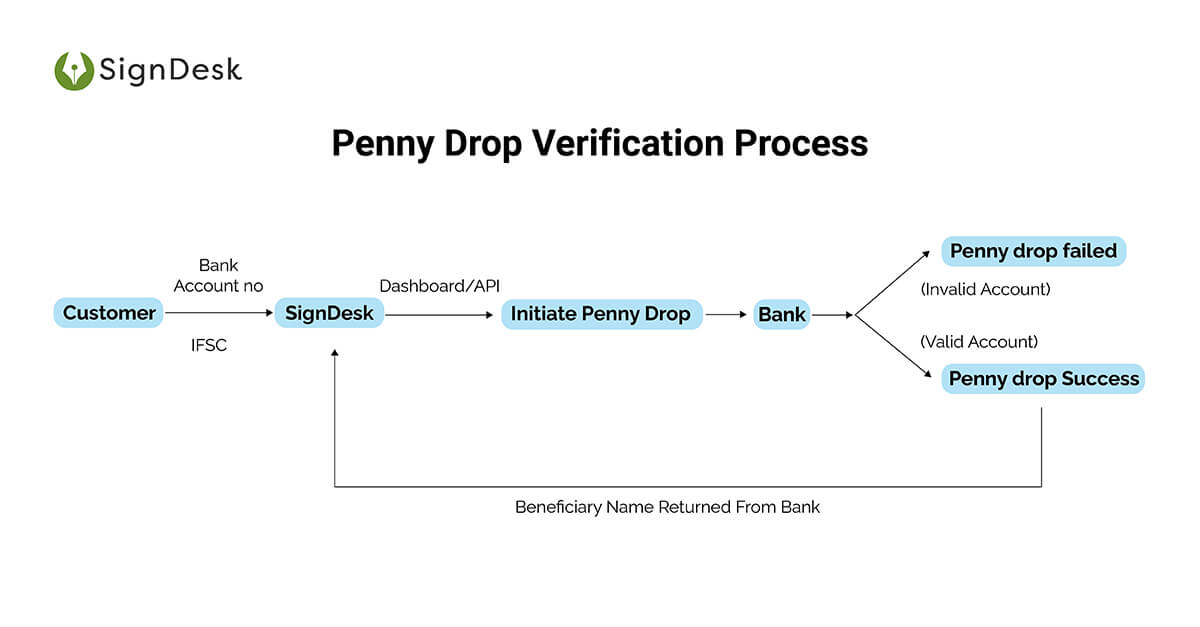Why Penny Drop Verification Used For Client Onboarding?

Penny drop verification is a form of bank account validation in which a penny, usually INR 1 (hence, the name), is deposited into the bank account. For example, if a business registers a new vendor, one of the foremost requirements would be to verify the vendor’s bank account details. This is done to ensure the validity of the account so that neither the business nor the vendor faces any problems during payment transfers.
The procedure not only verifies the authenticity of the customer’s bank account but also checks if the mentioned account is operative or not. In addition, the procedure also helps ascertain whether the account details provided belong to the same vendor or not.
Why Is It Important For Businesses to Verify Their Customers’ Bank Accounts?
The primary purpose of a business carrying out a penny drop bank account verification of its customers is to ensure that:
- The beneficiary bank account exists
- The bank account belongs to the same customer or not (through the account holder’s name validation)
- The bank account is active, i.e., the account is not frozen/closed and is accepting credits
Before onboarding their customers, businesses can easily verify the authenticity of their client’s bank accounts prior to initiating a money transfer with a penny drop. The method provides precise results regarding the bank account ownership so that businesses can be ensured the account belongs to the same client who is signing up for their services.
Bank Account Verification API
Bank account verification, which usually takes days to complete manually, is automated using penny drop APIs.
These APIs enable financial institutions including major banks and NBFCs to instantly and securely verify the bank account details of customers before proceeding to offer services.
Implementing these APIs is seamless and typically requires no assistance from third parties. Additionally, bank account verification APIs can be easily integrated into various customer journeys to ensure compliance with regulatory procedures and secure authentication.
Bank account verification APIs are simple and immensely useful tools for banks and NBFCs to automate and upscale operating capacity and improve functionality.
How Does the Penny Drop Verification Process Work?
Businesses can instantly verify their customers’ bank account validity by carrying out a simple penny drop procedure. The process that takes place is explained below.

- The customer shares their bank account number and IFSC with the penny drop service provider.
- The penny drop function is called through the service provider’s dashboard or penny drop API.
- The service provider’s system drops a penny (INR 1) into the customer’s bank account.
- The penny drop procedure succeeds if the customer’s bank account is valid.
- The process fails if the bank account is closed or invalid.
- After a successful penny drop transaction, the verified account status and beneficiary name are returned to validate the customer.
- However, if the bank account verification fails only the account status and the reason for failure are returned.
- Additionally, businesses can further verify the details of their customers by comparing the beneficiary name returned from the bank against the identity details provided in the application form.
Usage of Penny Drop Verification
Penny drop verification is a convenient method for businesses of all sizes to verify their clients’ bank accounts. With the help of penny drop, they can verify bank account details to prevent the risk of large-scale losses in the future.
Insurance money transfers, partial withdrawal requests, pension fund transfers, employee salary transfers, and many other transactions can be initiated with a penny drop. They can verify the retrieved account details against the KYC proofs/bank account details submitted by the client/employee so that the monetary transactions only happen between the business and the intended recipients.
In addition to verifying the details of the customer, this verification method also aids in cutting down fraud through identity thefts. With just a penny drop, organizations can take a significant step in eliminating heavy losses due to faulty money transfers.
Bank account verification is also essential for internal monetary transactions in a firm. Through penny drop, organizations can verify their employees’ bank account and ownership details before initiating salaries and reimbursements.
This helps prevent failed money transfers and salaries/expenses from being transferred to the wrong account, resulting in the employer and the employees remaining stress-free.
Conclusion
By transferring a nominal amount, say ₹1, to the bank account provided by the user, a business can receive the confirmation for the fund transfer along with the user’s details from the transferee bank.
The simple procedure can be beneficial for businesses as it prevents any fault before significant funds are transferred.
In addition, penny drop also plays a vital role in the annihilation of fraudulent fund transfer activities wherein the bank account belongs to a fraudster trying to defraud the business. This is very much necessary for businesses to restrain from facing unnecessary losses.
The penny drop bank account verification procedure must also be followed as the initial step before carrying out eMandates that would require the businesses to transfer money periodically. This can aid in preventing uncalled-for losses for the firm in the long run.
Penny drop is also an integral procedure that can be integrated with the KYC customer onboarding process, making bank account verification convenient for both the firm and its customers.
Learn how SignDesk seamlessly integrates penny drop verification with video-based remote KYC, CLM software and recurring eNACH processes to authenticate bank account details instantly. This process can prevent identity thefts, enabling businesses to secure their large-volume monetary transactions.